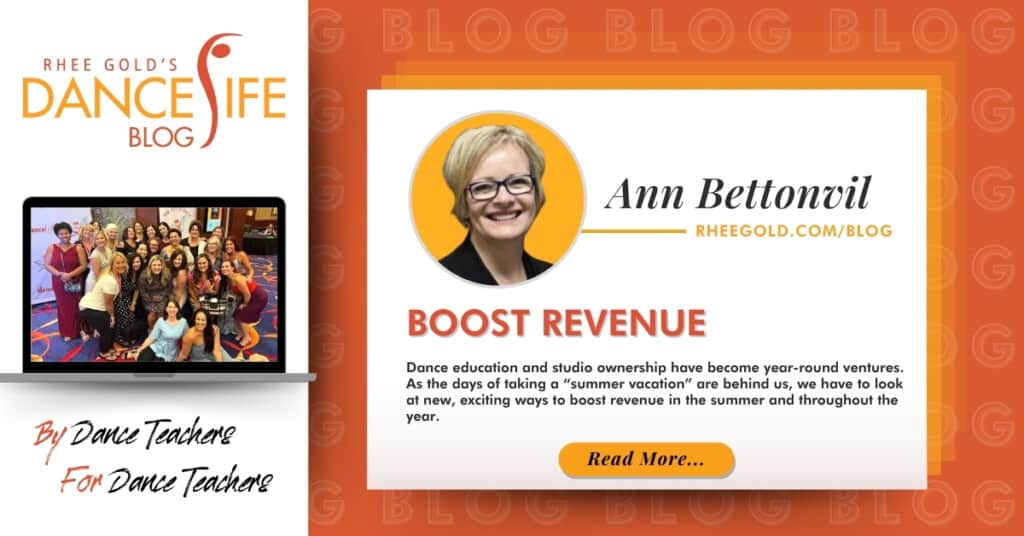Boost Revenue

When we initially took charge of our studio, the standard practice among studio owners was to shut down for the summer immediately after the year-end recital. The income generated from the recital was meant to sustain the studio during the lean summer months. Our dance teacher/studio owner had followed this approach during her ownership, so we continued the tradition. However, it became apparent that this business model was not sustainable. It seemed counterproductive to work hard in building a customer base, only to close the doors on them for almost three months each year, repeatedly and then build the customer base again.
That realization led us to introduce summer camps approximately 26 years ago. Nowadays, it's rare to find a studio that doesn't offer summer programs. Recognizing the need for revenue during the summer, we have transformed our summers into vibrant seasons filled with weekly camps, dance intensives, pop-up classes, and evening dance sessions.
Another realization we had was the importance of constantly introducing new and fresh elements. Keeping the schedule filled with the same routine becomes monotonous and lacks energy. Introducing new classes and programs not only adds excitement but also contributes to additional revenue. It opens up opportunities for siblings who may not be interested in dance or music lessons to join these innovative programs.
This year, we introduced a brand-new beginner adult jazz class to address the challenge of new participants joining our studio. While we previously offered two levels of adult jazz, we noticed that it was becoming increasingly challenging for newcomers to integrate. Currently, our class boasts a group of seven adults. They pay the most expensive tuition at one class a week (no multiple class discount).
Parent & Tot - We run 6-week sessions tailored for children aged 18-36 months. Although it took some time to gain momentum initially, it has now become a thriving aspect of our studio. What started as winter and spring sessions has expanded to cover the full year including summer.
Being the studio that parents know and love for their little ones has become a significant aspect of our identity. We also take advantage of the little ones about to turn 3 and let mom and dad know they can move up and go into class all by themselves! Moving them into our full season classes.
6 Weeks of Dance -This program has proven to be ideal for late starters and parents who prefer not to commit to a full year of dance. We offer these sessions for two age groups, 3-6 and 6-10, conducting three sessions starting in January and concluding in May, just before the year-end show. A strategic aspect of these classes is that they are scheduled in available slots on our calendar, making staffing more manageable as teachers are already present.
Over the 6-week duration, children get introduced to various dance styles, creating a diverse and engaging experience. A key selling point for parents is that there's no requirement for proper dance attire or shoes during these sessions, promoting a low-commitment approach. We even maintain a bin of donated tap shoes for tap week. If children decide to transition into full-year classes, they then understand the need to purchase proper shoes and uniforms.
Spring on Stage -Parents absolutely love this program! In just 10 weeks, their child learns a dance, receives a costume, and performs on stage in our year-end recital. While the focus isn't primarily on building extensive technique in such a short period, the goal is to ignite a passion for dance. We run three age groups: ages 3-6 and 6-9 for ballet, and ages 10-14 for contemporary.
This program boasts a remarkable retention rate, with many participants registering for our full-year program even before the recital takes place. Once they become full-year students, we can then concentrate on refining their technique. Recognizing the demand from adults, we're planning to introduce an Adult Spring on Stage program next year. We've observed an increasing number of adults expressing interest in joining classes in January and February. Offering this program allows us to capture their enthusiasm without the constraints of the full-year class schedule. While we currently provide adult summer classes, we may lose them if they have to wait 4 months.
Art Club - Exciting news this year! We've introduced a new program called Art Club, spanning six sessions from October to March. What makes this initiative even more special is the collaboration with one of our adult students who happens to be an art teacher. When I approached her about leading Art Club, she was thrilled to get involved.
Art Club distinguishes itself from traditional arts and crafts classes. During a two-hour session each month, kids with a passion for art have the opportunity to create something truly remarkable. The activities range from acrylic painting, printmaking, watercolor painting, pottery, pencil portraits, to pastels. The response has been overwhelmingly positive, with inquiries pouring in about the possibility of continuing Art Club or offering it during the summer.
Certainly, these developments didn't occur overnight. Building up the success of the 6-week programs and our Parent/Tot initiative required time and dedication. We experimented with a beginner adult jazz class a few years ago, and although it didn't initially take off, we persevered and eventually found success. The introduction of Spring on Stage, initiated two years ago, was an instant hit from the beginning.
Art Club, while not a major revenue source, brings a valuable and fresh addition to our programming.It fosters a sense of community for kids who have a passion for art. The joy comes not only from the unique offerings but also from the fact that the teacher enjoys the experience as much as the students do. It provides a community for art loving kids and the teacher loves teaching it because the kids that attend really want to learn.
This highlights the significant impact of additional programs on studio finances, allowing for the allocation of funds towards essential aspects like front desk staff, vacations, staff bonuses, or retreats. It prompts reflection on what can enhance the efficiency of your studio or contribute to a better work/life balance.
In the past, like many others, we believed we couldn't afford a front desk staff and handled all responsibilities ourselves. However, introducing extra programs has allowed us not only to afford a front desk staff but also to bring in a cleaning team and an Events Coordinator. These additions have contributed immensely to building our community and maintaining our studio culture.
Consider starting small and gradually expanding. Identify the staff you need for the upcoming year and calculate the associated costs. Then, design a program that generates revenue to cover those expenses. If you're interested in exploring revenue totals and discussing what's possible, feel free to reach out. I'm more than happy to share insights and experiences.









